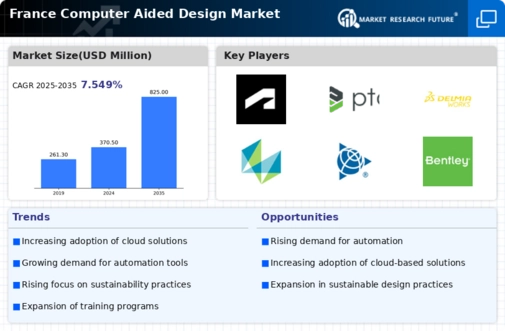Collaboration Across Industries
Collaboration across various industries is emerging as a key driver for the computer aided-design market in France. As sectors such as construction, manufacturing, and fashion increasingly intersect, the need for integrated design solutions becomes apparent. This trend is projected to contribute to a market growth of around 11% as companies seek to streamline their design processes through collaborative CAD platforms. The ability to share designs and ideas in real-time fosters innovation and accelerates project timelines. Additionally, cross-industry partnerships are likely to lead to the development of new design methodologies that leverage the strengths of different sectors. This collaborative spirit not only enhances the efficiency of the design process but also positions the computer aided-design market as a vital component in the broader landscape of industrial innovation.
Rising Demand for Customization
Customization is becoming a pivotal driver in the computer aided-design market in France. As consumer preferences shift towards personalized products, industries such as automotive and consumer electronics are increasingly relying on CAD tools to meet these demands. The market is expected to witness a growth rate of around 12% in the coming years, as businesses leverage CAD software to create tailored solutions. This trend is particularly evident in sectors where unique designs can significantly enhance user experience and brand loyalty. Moreover, the ability to quickly prototype and iterate designs using CAD tools allows companies to respond swiftly to market changes. This responsiveness is crucial in maintaining a competitive edge, suggesting that the computer aided-design market will continue to thrive as customization becomes a standard expectation among consumers.
Increased Focus on User Experience
The emphasis on user experience is greatly impacting the computer aided-design market in France. As industries recognize the importance of intuitive design, CAD tools are evolving to incorporate user-friendly interfaces and enhanced functionality. This shift is expected to drive market growth by approximately 10% as companies prioritize designs that resonate with end-users. The integration of user feedback into the design process is becoming more prevalent, allowing for iterative improvements that enhance product usability. Furthermore, the rise of virtual reality (VR) and augmented reality (AR) technologies is likely to transform how designers visualize and present their work. This focus on user-centric design indicates a promising trajectory for the computer aided-design market, as firms strive to create products that not only meet functional requirements but also provide exceptional user experiences.
Technological Advancements in CAD Software
The computer aided-design market in France is experiencing a surge due to rapid technological advancements in CAD software. Innovations such as parametric modeling, 3D visualization, and real-time rendering are enhancing design capabilities. In 2025, the market is projected to grow by approximately 15%, driven by the increasing demand for sophisticated design tools across various sectors, including architecture and engineering. These advancements not only improve efficiency but also reduce time-to-market for new products. As companies seek to remain competitive, the adoption of cutting-edge CAD solutions becomes imperative. Furthermore, the integration of machine learning algorithms into CAD software is likely to streamline workflows, enabling designers to focus on creativity rather than repetitive tasks. This trend indicates a robust future for the computer aided-design market in France, as firms invest in technology to enhance their design processes.
Government Initiatives Supporting Innovation
Government initiatives in France are playing a crucial role in fostering innovation within the computer aided-design market. Various funding programs and grants are available to support research and development in design technologies. In 2025, it is anticipated that public investment in digital transformation will increase by 20%, directly benefiting the CAD sector. These initiatives aim to enhance the competitiveness of French industries by promoting the adoption of advanced design tools. Additionally, partnerships between government bodies and educational institutions are likely to cultivate a skilled workforce adept in modern CAD applications. This collaborative approach not only stimulates growth in the computer aided-design market but also ensures that France remains at the forefront of design innovation in Europe.
























Leave a Comment